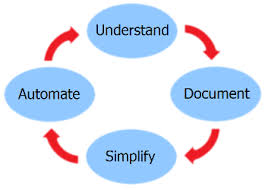 In our prior post, we noted that companies need to order and reengineer their processes first, and then think about the software they’ll use to bake those into the company’s mode of operation. Today we conclude that post by sharing 7 steps that we think make a lot of sense, as recently published in an article by Panorama Consulting entitled “7 Business Process Reengineering Tips For Competitive Advantage” which you can find here. They said it well, so we’ll excerpt some of their comments below.
In our prior post, we noted that companies need to order and reengineer their processes first, and then think about the software they’ll use to bake those into the company’s mode of operation. Today we conclude that post by sharing 7 steps that we think make a lot of sense, as recently published in an article by Panorama Consulting entitled “7 Business Process Reengineering Tips For Competitive Advantage” which you can find here. They said it well, so we’ll excerpt some of their comments below.
- Budget adequate time and resources. Business process reengineering takes time. In fact, it takes more time than the technical configuration, testing and implementation of ERP software. It probably took your organization years to adopt your current processes, so it will likely take some time to change those well-established processes. You should ensure sufficient time for defining, improving and implementing new business processes. Benchmarking against organizations of similar size and industry will help you set realistic expectations for your project.
- Define business requirements before selecting ERP software. Organizations often find that modern ERP systems are too flexible to simply start using out of the box. Even the simplest business processes have multiple workflow options. This complexity will slow down your project if your business processes aren’t well defined before the design and build phases of your implementation.
- Improve business processes before selecting ERP software. Just as you should define business requirements before software selection, you should also improve your processes as early as possible. This is also the time to consider whether your processes align with your long-term organizational strategy.
- Don’t treat all business processes equally. It’s easy to be overwhelmed by the number of business processes you need to document, analyze and improve. So start by focusing on just the processes that are competitive differentiators. These processes should drive your selection of ERP software and shouldn’t be constrained by software best practices, which may not be best practices for your unique operations.
- Integrate business process reengineering with change management. Resistance to change is one of the main reasons business transformation takes longer than expected. Ensuring employees understand and accept new processes is challenging because people naturally dislike change. Before training employees, you should identify the gaps between your current and future state, so employees understand new processes in the context of their day-to-day jobs.
- Integrate analytics into business processes. ERP vendors offer innovative solutions that leverage business intelligence and predictive analytics, often utilizing AI technologies. When defining your future state business processes, you should include processes for analyzing and acting on data. Chances are, most of your competitors don’t have a strategy for leveraging AI nor have they implemented this innovative technology.
- Measure results and make incremental improvements. Measuring post-implementation results helps you stay on track to realizing expected business benefits. Continually measuring incremental benefits realization allows you to make corrections as needed. Misalignment between business requirements and software functionality can deter benefits realization. Lack of employee buy-in can also create a roadblock.
 Every company wants its business software (or ERP system) to support the way their underlying business works. It only makes sense, and with today’s business systems, that capability is actually within reach.
Every company wants its business software (or ERP system) to support the way their underlying business works. It only makes sense, and with today’s business systems, that capability is actually within reach. In our
In our  We regularly engage new clients for business process analyses because we’ve learned over the years that it’s the
We regularly engage new clients for business process analyses because we’ve learned over the years that it’s the 




